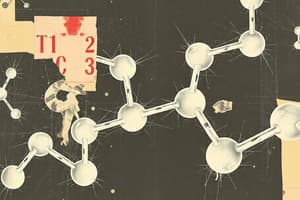Podcast
Questions and Answers
What is hydrogen bonding?
What is hydrogen bonding?
An intermolecular force between molecules with an -OH/-NH group and molecules with an N/O atom.
Hydrogen bonds are weaker than permanent dipole-dipole forces.
Hydrogen bonds are weaker than permanent dipole-dipole forces.
False (B)
What results in the formation of a permanent dipole in a molecule?
What results in the formation of a permanent dipole in a molecule?
A delta positive H and a delta negative O/N due to electronegativity.
How does hydrogen bonding occur in water molecules?
How does hydrogen bonding occur in water molecules?
What are intramolecular forces?
What are intramolecular forces?
Which of the following are types of intramolecular forces?
Which of the following are types of intramolecular forces?
The three types of intramolecular forces are ionic, covalent, and __________.
The three types of intramolecular forces are ionic, covalent, and __________.
What are intermolecular forces also called?
What are intermolecular forces also called?
What are permanent dipole-permanent dipole forces?
What are permanent dipole-permanent dipole forces?
Ionic bonding is the weakest force among the types of bonding.
Ionic bonding is the weakest force among the types of bonding.
Which type of intermolecular force is the weakest?
Which type of intermolecular force is the weakest?
What is hydrogen bonding?
What is hydrogen bonding?
The bond between hydrogen and an electronegative atom becomes highly __________.
The bond between hydrogen and an electronegative atom becomes highly __________.
Which of the following groups can form hydrogen bonds?
Which of the following groups can form hydrogen bonds?
Water can form a maximum of three hydrogen bonds per molecule.
Water can form a maximum of three hydrogen bonds per molecule.
What are the anomalous properties of water caused by hydrogen bonding?
What are the anomalous properties of water caused by hydrogen bonding?
Ice floats on water because of ice's __________ density.
Ice floats on water because of ice's __________ density.
What causes the high enthalpy change of vaporization in water?
What causes the high enthalpy change of vaporization in water?
Electronegativity is the ability of an atom to repel electrons.
Electronegativity is the ability of an atom to repel electrons.
What happens to the dipole moment when two atoms in a covalent bond have different electronegativities?
What happens to the dipole moment when two atoms in a covalent bond have different electronegativities?
What type of forces are London dispersion forces?
What type of forces are London dispersion forces?
How do permanent dipole-permanent dipole forces arise?
How do permanent dipole-permanent dipole forces arise?
Butane has a higher boiling point than propanone.
Butane has a higher boiling point than propanone.
Flashcards are hidden until you start studying
Study Notes
Hydrogen Bonding
- Strongest form of intermolecular bonding, occurs between molecules.
- Requires an electronegative atom (O or N) with a lone pair and an -OH or -NH group.
- When hydrogen is bonded to O or N, the bond is highly polarized, creating a δ+ charged hydrogen capable of forming a bond with another molecule’s lone pair.
- Hydrogen bonds require a 180° angle between -OH/-NH and the hydrogen bond.
- Ammonia can form one hydrogen bond; water can form four hydrogen bonds.
- Hydrogen bonding contributes to water's high melting/boiling points, surface tension, and the anomalous density of ice.
Properties of Water
- High melting and boiling points due to strong hydrogen bonds requiring substantial energy to overcome.
- Water's structure leads to a high enthalpy of vaporization, significantly influenced by hydrogen bonding.
- High surface tension allows water's surface to resist external forces, as surface water molecules are attracted to each other via hydrogen bonds.
- Ice has a lower density than liquid water because of its open hydrogen-bonding network, allowing water to float.
Bond Polarity & Dipole Moments
- Electronegativity defines an atom's ability to attract electrons; it increases across a period and decreases down a group.
- Nonpolar covalent bonds occur when atoms have identical electronegativities; polar covalent bonds exist when there is a difference.
- Polar bonds result in partial charges (δ+ and δ-), creating an asymmetric electron distribution.
- The dipole moment measures bond polarity, indicated by an arrow pointing toward the negative end.
- Molecule polarity depends on the arrangement of polar bonds; some molecules may have polar bonds that cancel each other out and are overall nonpolar.
Van der Waals' Forces
- Weaker than covalent bonds, van der Waals' forces include instantaneous dipole-induced dipole (London dispersion forces) and permanent dipole-permanent dipole forces.
- Instantaneous dipoles arise from shifting electron cloud distributions, inducing dipoles in neighboring molecules.
- Permanent dipoles result from polar covalent bonds with distinct charge distributions.
- Permanent dipole forces are generally stronger than instantaneous dipole forces, impacting boiling points.
Inter & Intramolecular Forces
- Intramolecular forces reside within a molecule, including ionic, covalent, and metallic bonding.
- Ionic bonding involves electrostatic attraction between cations and anions in a lattice formed by electron transfer.
- Covalent bonds occur through sharing of outer electrons, while metallic bonds are due to attractions between metal ions and delocalized electrons.
- Intermolecular forces act between molecules, influencing physical properties such as phase changes and boiling points.### Intramolecular Forces
- Three types of intramolecular forces are ionic, covalent, and metallic bonding.
Intermolecular Forces
- Intermolecular forces, also known as van der Waals' forces, occur between molecules.
- Permanent dipole - permanent dipole forces result from attractive interactions between neighboring molecules that each possess a permanent dipole.
- Hydrogen bonds are a specific kind of permanent dipole - permanent dipole interaction, characterized by strong attractions involving hydrogen atoms.
- Instantaneous dipole - induced dipole (London dispersion) forces arise from temporary dipoles that induce a dipole in neighboring molecules.
Strength of Bonds
- Generally, intramolecular forces are stronger than intermolecular forces.
- Ionic bonding is regarded as the strongest type of force among bonds, while instantaneous dipole - induced dipole forces are the weakest.
Studying That Suits You
Use AI to generate personalized quizzes and flashcards to suit your learning preferences.


